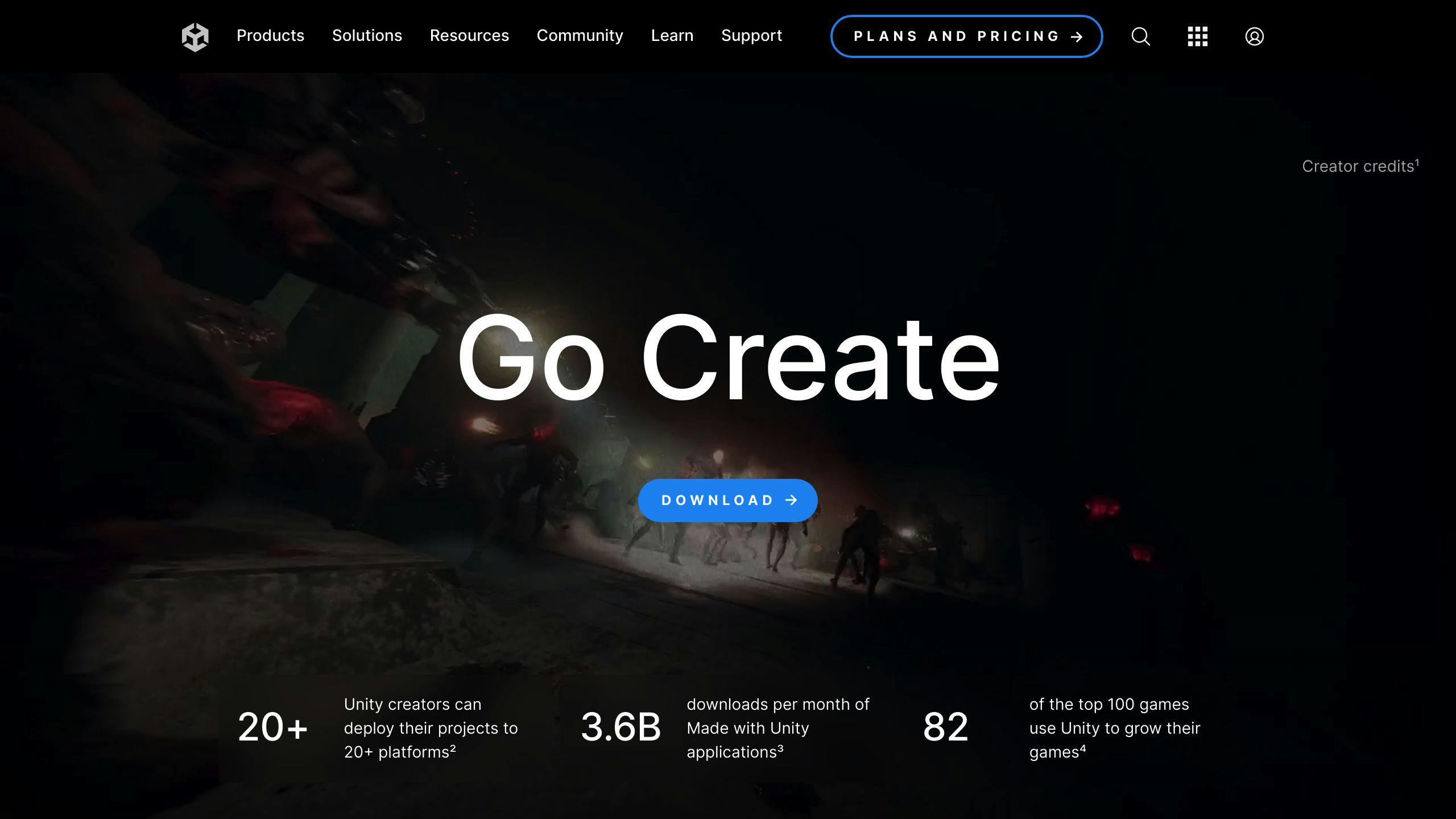Creating responsive UI layouts in Unity is crucial for ensuring your app or game provides an optimal user experience across different devices and screen sizes. This guide covers the essential techniques for building UIs that dynamically adapt to various resolutions, orientations, and aspect ratios.
Related video from YouTube
Key Takeaways
- Set up the Canvas and configure the Canvas Scaler component to handle different screen sizes
- Use anchors and anchor presets to position UI elements relative to their parent
- Leverage layout groups (horizontal, vertical, grid) for automatic element arrangement
- Implement Content Size Fitters to dynamically resize elements based on content
- Combine anchoring, layout groups, and Content Size Fitters for advanced responsive design
- Optimize performance by minimizing draw calls, using batching and atlasing
- Test your UI on different devices and resolutions, debug layout issues
Quick Comparison: Layout Groups
Layout GroupPurposeAdvantagesHorizontalArrange child elements horizontallySimplifies horizontal arrangements, supports dynamic resizing, automatic alignmentVerticalArrange child elements verticallySimplifies vertical arrangements, supports dynamic resizing, automatic alignmentGridArrange child elements in a gridSupports complex grid layouts, automatic alignment, ideal for tables or matrices
By following the techniques outlined in this guide, you can create user interfaces that adapt seamlessly to any device, ensuring a consistent and engaging experience for your users.
Getting Started
To create responsive UI layouts in Unity, you need to understand Unity's UI components and layout system. This guide assumes you have basic knowledge of Unity and C# scripting.
Understanding Unity UI

Unity's UI system revolves around the Canvas, which is the area where all UI elements reside. The Canvas scales to fit all screen sizes, ensuring your UI looks consistent across different devices. To start building your UI:
- Create a Canvas: Go to
GameObject>UI>Canvas. This will be the parent object for all your UI elements. - Add UI elements: Go to
GameObject>UIand select the element you need, such asButton,Text,Image, etc.
C# Scripting Basics
Understanding C# scripting is crucial for advanced techniques in Unity's UI system. You'll need to know how to:
- Write scripts to manipulate UI elements
- Respond to user input
- Adjust to different screen sizes and orientations
If you're new to C# scripting, start by learning the basics of C# programming and Unity's scripting API.
Setting Up the Canvas
Setting up a responsive UI layout in Unity starts with creating a new Canvas and configuring the Canvas Scaler component. This section will guide you through the initial setup process.
Creating a New Canvas
To create a new Canvas:
- Go to
GameObject>UI>Canvas. - This will create a new Canvas game object in your scene. The Canvas is the root object for all your UI elements.
Canvas Scaler Component
The Canvas Scaler component controls how UI elements scale with different screen sizes. To add the Canvas Scaler component:
- Select the Canvas game object.
- Go to
Add Component>UI>Canvas Scaler.
Configuring Canvas Scaler
The Canvas Scaler component has several properties that need to be configured:
PropertyFunctionUI Scale ModeDetermines how the UI elements scale with different screen sizes.Reference ResolutionThe resolution that the UI is designed for.Screen Match ModeControls how the UI adjusts to different screen sizes and orientations.MatchA value between 0 and 1 that determines how the UI scales with different screen sizes.
To configure the Canvas Scaler:
- Set
UI Scale ModetoScale With Screen Size. This allows the UI elements to scale with different screen sizes. - Set
Reference Resolutionto the resolution that your UI is designed for, such as 1080p or 4K. - Set
Screen Match ModetoMatch Width or Height. This allows the UI to adjust to different screen sizes and orientations.
Anchoring UI Elements
Anchoring UI elements is key to making responsive UI layouts in Unity. Anchors set the position and scaling of UI elements relative to their parent, helping them fit different screen sizes and resolutions.
What are Anchors?
Anchors are points that define how a UI element is positioned and scaled within its parent. In Unity, anchors are shown as four triangles forming an X. When you select a UI element, you can see its anchors in the Scene view.
Using Anchor Presets
Unity offers several anchor presets for common anchoring scenarios. To use an anchor preset:
- Select the UI element you want to anchor.
- In the Rect Transform component, click on the anchor preset button.
- Choose the desired preset (e.g., top-left, center, bottom-right).
For example, to anchor a button to the lower-right corner of the screen, choose the bottom-right preset. This keeps the button in the same position relative to its parent, even when the screen size or resolution changes.
sbb-itb-8abf120
Layout Groups
Learn how layout groups can automate the positioning and sizing of UI elements.
Types of Layout Groups
Unity offers three types of layout groups: Horizontal, Vertical, and Grid. Each type helps in arranging UI elements in a specific way.
Layout GroupPurposeAdvantagesHorizontalArrange child elements in a horizontal lineSimplifies horizontal arrangements, supports dynamic resizing, and offers automatic alignmentVerticalArrange child elements in a vertical lineSimplifies vertical arrangements, supports dynamic resizing, and offers automatic alignmentGridArrange child elements in a gridSupports complex grid layouts, offers automatic alignment, and is ideal for tables or matrices
Configuring Layout Groups
To set up a layout group:
- Select the UI element you want to group.
- Add the corresponding layout group component (e.g., Horizontal Layout Group, Vertical Layout Group, or Grid Layout Group).
- Adjust the properties to achieve the desired behavior.
For example, to create a horizontal layout group:
- Add the Horizontal Layout Group component to the parent element.
- Set the
Child Alignmentproperty toMiddle Centerto center the child elements horizontally.
Pros and Cons
AdvantagesDisadvantagesAutomates UI element positioning and sizingLimited control over advanced positioning and layout customizationSupports responsive design and dynamic resizingCan be complex to set up and configureSimplifies UI layout creation and managementMay not be suitable for complex, custom layouts
Content Size Fitters
Content Size Fitters help automatically adjust the size of UI elements based on their content. This is useful for dynamic text, images, or other elements that change size during runtime.
What are Content Size Fitters?
A Content Size Fitter is a Layout Controller that adjusts the size of the Rect Transform based on the content. It can be added to any UI element, like Text, Image, or Layout Group, to resize it dynamically.
The Content Size Fitter has two main properties: Horizontal Fit and Vertical Fit. These properties control how the UI element resizes to fit its content. You can set these properties to Unconstrained, Min Size, or Preferred Size.
Setting Up Content Size Fitters
To set up a Content Size Fitter:
- Select the UI element you want to resize.
- Add a Content Size Fitter component to the element.
- Configure the Horizontal Fit and Vertical Fit properties.
For example, to make a Text component resize to fit its content, set both Horizontal Fit and Vertical Fit to Preferred Size. This ensures the Text component resizes to fit the text without clipping or leaving extra space.
Advanced Techniques
Combining Techniques
To create responsive UI layouts, you need to use multiple methods together. This ensures your UI works well on different screen sizes and orientations. For example, you can use Content Size Fitters to adjust the size of UI elements and Anchors to position them correctly.
Steps to combine techniques:
- Identify UI elements that need dynamic resizing.
- Add a Content Size Fitter to each element to adjust its size based on content.
- Use Anchors to position the resized elements correctly.
- Test your UI layout on different devices and screen sizes.
Scripting UI Layout Changes
Sometimes, you need to adjust your UI layout using C# scripts. This is useful for responding to events or changes in your game or app. For example, you can:
- Adjust the UI layout based on user settings.
- Add or remove UI elements based on game state or user input.
- Animate UI elements for a better user experience.
Steps to script UI layout changes:
- Create a new C# script in Unity and attach it to the relevant UI element or game object.
- Use Unity's UI API to access and manipulate the UI elements.
- Write code to adjust the UI layout based on your needs.
- Test your script to ensure it works correctly and doesn't cause performance issues.
Handling Orientation and Aspect Ratio
It's important to design your UI to work in different orientations and aspect ratios, especially for mobile devices.
Tips for handling orientation and aspect ratio changes:
- Use Unity's built-in support for screen orientation and aspect ratio changes.
- Design your UI layout to work in both portrait and landscape modes.
- Use Anchors and Content Size Fitters to adjust the size and position of UI elements.
- Test your UI layout on different devices and screen sizes.
Optimizing Performance
Optimizing performance is key to ensuring your responsive UI layout runs smoothly. A well-optimized UI layout can improve the user experience and increase engagement.
Optimizing UI Layouts
Follow these best practices to optimize your UI layout:
- Use a single Canvas: Multiple Canvases can cause performance issues. Use one Canvas and organize your UI elements within it.
- Remove unnecessary elements: Get rid of UI elements that are not visible or used. This reduces draw calls and improves performance.
- Use caching: Cache frequently used UI elements to reduce GPU load.
- Optimize font rendering: Use font atlasing and batching to optimize font rendering and reduce draw calls.
Batching and Atlasing
Batching and atlasing help reduce draw calls and improve performance.
TechniqueDescriptionBatchingCombines multiple UI elements into a single draw call.AtlasingCombines multiple textures into a single atlas.
To implement these techniques:
- Batching strategy: Combine multiple UI elements into a single draw call.
- Texture atlas: Combine multiple textures into a single atlas.
- Sprite atlasing: Combine multiple sprites into a single atlas.
Avoiding Layout Rebuilds
Layout rebuilds can be costly and impact performance. To avoid them:
TipDescriptionStable layoutDesign a layout that doesn't need frequent rebuilds.Avoid dynamic contentMinimize the use of dynamic content that causes rebuilds.Layout cachingCache layout information to reduce rebuilds.
Testing and Debugging
Testing and debugging are key steps to ensure your responsive UI layout works well on different devices and resolutions. This section covers guidelines and tools for testing and fixing common issues.
Testing Techniques
To test your responsive UI layout, simulate different devices, resolutions, and aspect ratios. Here are some techniques:
- Unity's built-in tools: Use the Game View to test your UI on various devices and resolutions.
- Physical devices: Test on real devices to ensure your UI works as expected.
- Online tools: Use tools like BrowserStack or CrossBrowserTesting to test your UI on different devices and browsers.
Using Game View
Unity's Game View is a powerful tool for testing your UI layout. Here's how to use it:
- Select a device: Choose a device from the Game View toolbar.
- Adjust the resolution: Change the resolution to test different screen sizes.
- Test orientation and aspect ratio: Check your UI in different orientations and aspect ratios.
Debugging Layout Issues
Common pitfalls in UI design can lead to layout issues. Here are some common problems and solutions:
IssueSolutionElement not resizingCheck the anchor settings and ensure the element resizes with its parent.Element not positioning correctlyVerify the anchor settings and ensure the element is positioned correctly within its parent.Layout not responding to screen size changesCheck the Canvas Scaler settings and ensure the layout responds to screen size changes.
Wrapping Up
Responsive UI Recap
In this guide, we've covered how to create responsive UI layouts in Unity. From the basics of Unity UI to advanced performance tips, we've shown how to design UIs that work well on different screens. By following these steps, you can make UIs that look good and work well on any device.
Summary of Techniques
Here's a quick recap of the techniques we've discussed:
- Unity UI Basics: Understanding Unity UI and its components
- Canvas Setup: Setting up the canvas and configuring the Canvas Scaler
- Anchoring Elements: Anchoring UI elements and using anchor presets
- Layout Groups: Working with layout groups and content size fitters
- Advanced Design: Combining techniques for advanced responsive design
- Performance Tips: Optimizing performance using batching, atlasing, and avoiding layout rebuilds
Further Learning
To keep improving your skills in responsive UI design, check out these resources:
- Unity's Official Documentation: Learn more about Unity UI and responsive design.
- Online Tutorials: Find tutorials that cover specific topics in Unity UI.
- Community Forums: Join forums like the Unity subreddit to get tips and feedback from other developers.








